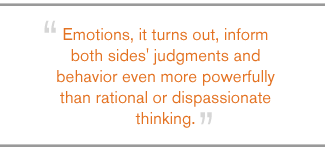In the process of working with some of the best run companies in the world, we have learned a great deal about how the world's finest organizations unleash the power of their human systems and how the worst fail to do so. Though the specific ways that the HumanSigma [management] model may be implemented in your company may vary, the underlying philosophy can be boiled down to five new rules, which we list here . . .
Rule 1: You can't measure and manage the employee and customer experiences as separate entities. Because you must manage these human systems in tandem, you may need to reorganize.
This is not a trivial issue. Most companies are not currently organized or prepared to manage employees and customers under the same organizational umbrella. But because the crucial juncture in creating value in sales and service organizations is the interaction between employees and customers, you must view both sides of the employee-customer encounter as interrelated and mutually dependent. As a result, you must assess and manage these human systems as a coherent whole, not as separate pieces. In practice, this means that you cannot separate the responsibility for the quality of a company's employee relationships from the responsibility for the quality of its customer relationships. They are interdependent, and you must not manage them in isolation.
Who owns the employee experience at your company? Who owns the customer experience? How well integrated are your efforts to assess and manage the employee-customer encounter?
Rule 2: Emotion frames the employee-customer encounter. It's important not to think like an economist or an engineer when you're assessing employee-customer interactions. Emotions, it turns out, inform both sides' judgments and behavior even more powerfully than rational or dispassionate thinking. Because employees and customers are people first and employees or customers second, they are prone to all the volatility and irrationality that is the hallmark of being human.
If companies are ever going to be able to truly understand their employees and customers, it's crucial that they take their employees' and customers' essential humanity seriously. Historically, this has been a tough sell because emotions or feelings have been viewed as messy, imprecise, nettlesome things that don't lend themselves well to rigorous management science. Besides, emotions don't conform to rational rules.

|
But it's possible to reliably evaluate the emotional dimensions that are important to employees and customers. The measurement and management of the employee-customer encounter must acknowledge and incorporate the crucial emotional infrastructure of human behavior and decision making, yielding a concept that extends beyond traditional considerations of employee and customer satisfaction to a concept we call engagement.
Have you incorporated these emotional components into your understanding of what drives your employee and customer relationships?
Rule 3: You must measure and manage the employee-customer encounter at a local level. Though companies can manage many kinds of organizational activities effectively from the top down, the employee-customer encounter is an intensely local phenomenon that can vary considerably from location to location within the same company. Because of the variability in local performance, you must measure and manage it locally.
Are your corporate metrics and other activities aligned to support local accountability and action?
Rule 4: We can quantify and summarize the effectiveness of the employee-customer encounter in a single performance measure -- the HumanSigma metric -- that is powerfully related to financial performance. Our research has revealed that the two sides of the employee-customer encounter potentiate one another and can be quantified into a single HumanSigma metric. The interactive effects of employee and customer engagement at the local level exponentially drive operational and financial performance and growth.
Does your company suffer from either an overabundance or a shortage of human systems performance metrics? How well integrated are the metrics you use? And how well do these metrics link up to your company's financial performance outcomes?
Rule 5: Improvement in local HumanSigma performance requires deliberate and active intervention through attention to a combination of transactional and transformational intervention activities. Measurement by itself is never enough to improve performance. Creating organizational change is hard work and requires active and disciplined intervention.
Our work has found that few companies apply the full range of intervention activities required to generate real and sustainable change. Transactional activities, such as action planning, training, and other aggressive interventions, are cyclical interventions that tend to be topical and short-term in focus and to recur regularly. They are designed to help your company do what it already does -- but do it better. Transformational activities, on the other hand, are structural interventions that focus on how companies select employees, select and promote managers, pay and evaluate employees, do succession planning, and recognize and develop employees. Transformational activities focus on creating an organizational infrastructure that supports HumanSigma. They are designed to help your company come up with new ways to do things.
What processes do you have in place to support a HumanSigma strategy in your organization?